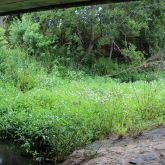Senegal tea

Senegal tea plant form
© Queensland Government

Senegal tea flower close-up
© Queensland Government

Senegal tea infestation
© Queensland Government

Senegal tea leaf
© Queensland Government

Senegal tea plant flower
© Queensland Government

Senegal tea plant flowers at the tip of erect stalks
© Queensland Government

Senegal tea plant infestation
© Queensland Government

Senegal tea stem and opposing leaf characteristic
© Queensland Government
Native to South America, Senegal tea is an aquatic perennial introduced to Australia as an aquarium plant. In the wild, it invades and degrades natural wetlands. The first infestations of Senegal tea were found in New South Wales and Tasmania.
Scientific name
Description
- This aquatic perennial grows over water surfaces, producing runners and floating stems up to 2.5m long.
- On land, it grows as a rounded bush.
- Leaves are shiny, dark green, 5–20cm long and in opposite pairs.
- Stems are hollow between nodes, allowing the plant to float.
- Young stems are light green with dark green blotches.
- Young stems are round, becoming 6-sided as the plant grows.
- Flowers are white, pompom-like and 15–20mm in diameter.
- Seeds are yellow-brown and ribbed.
3D model
- View the 3D model to help you identify this plant. You can magnify the image and manipulate the view to inspect the plant from every angle.
Habitat
- Favours shallow and slow-moving water.
- Can grow over a water surface or in wet, marshy soils.
Distribution
- Visit the Weeds Australia website and click on the distribution tab to view the distribution map.
Life cycle
- Seeds germinate in spring and, if conditions are right, in summer.
- Flowering starts in late spring to early summer.
- The plant becomes dormant when temperatures drop.
Affected animals
- Wetland birds
Impacts
Environmental
- Forms floating mats, blocking irrigation ditches, shallow dams and waterways.
- Invades and degrades natural wetlands.
How it is spread
- Cultivation and sale as an aquarium or ornamental water plant
- Dumping of aquarium contents into waterways
- Movement of broken stems, leaf fragments and seeds via:
- water
- soil on vehicle tyres and animals' feet
Prevention
Control
Before you attempt to control an infestation of Senegal tea, contact us online, by phone or in person. The plant must be positively identified before control so that all occurrences can be recorded.
Mechanical control
- Place all removed plant material in sealed plastic bags, leave the bags in sunlight for the plant material to decompose, then dispose of the bags at a council-approved landfill tip. Alternatively, leave the material in the sun to dry, then burn it.
- Do not leave broken plant pieces in growth areas.
Herbicide control
- Biosecurity Queensland is seeking a minor use permit from the Australian Pesticides and Veterinary Medicines Authority for suitable herbicides.
See the Senegal tea fact sheet for herbicide control and application rates.
Biological control
- No known biological control agents.
Legal requirements
- Senegal tea is a category 3 restricted invasive plant under the Biosecurity Act 2014. You must not:
- give it away
- sell it
- release it into the environment.
- You must take all reasonable and practical measures that are under your control to minimise the biosecurity risks associated with dealing with Senegal tea. This is part of your general biosecurity obligation.
- Each local government must have a biosecurity plan that covers invasive plants in its area. This plan may include actions to be taken on Senegal tea. Some of these actions may be required under local laws. Contact your local government for more information.
If you do any of these, penalties may apply.
Further information
- Contact us online, by phone or in person.
- Read the Senegal tea fact sheet.
- View the Senegal tea 3D model.